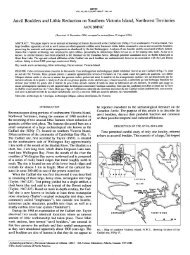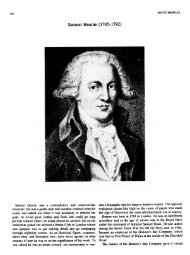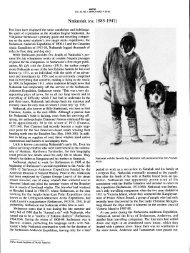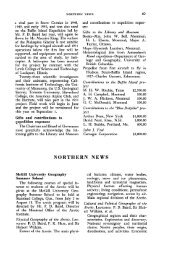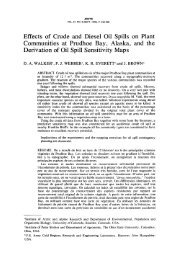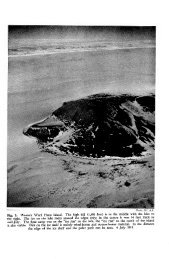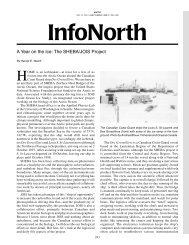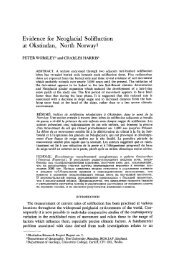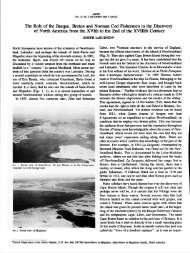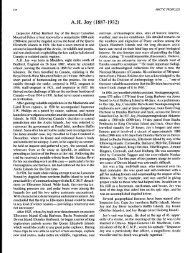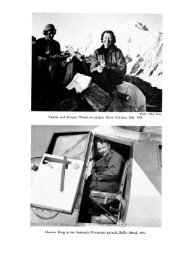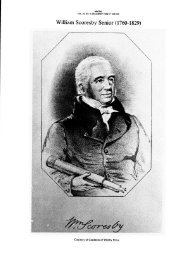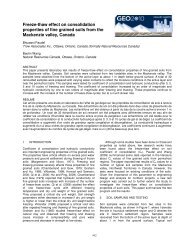NOTES ON THE NUNAMIUT ESKIMO AND MAMMALS OF ... - arctic
NOTES ON THE NUNAMIUT ESKIMO AND MAMMALS OF ... - arctic
NOTES ON THE NUNAMIUT ESKIMO AND MAMMALS OF ... - arctic
Create successful ePaper yourself
Turn your PDF publications into a flip-book with our unique Google optimized e-Paper software.
172 <strong>THE</strong> <strong>NUNAMIUT</strong> ESKIAIO <strong>AND</strong> <strong>MAMMALS</strong> <strong>OF</strong> <strong>THE</strong> ANAKTUVUK PASS REGI<strong>ON</strong><br />
of a wolf, but not so large as to allow foxes to escape. This trap was mentioned<br />
by Stefansson (1914, p. 388).<br />
The isiwogak, consisting of a strip of baleen sharpened at both ends, coiled,<br />
and frozen inside a ball of blood, was formerly used by the Nunamiut for both<br />
foxes and wolves. The proper length of the isiwogak for foxes was equal to<br />
the distance from the middle of the palm of the hand to the end of the longest<br />
finger. Such baits were placed where they would be swallowed by foxes or<br />
wolves, and when the body heat had thawed the ball, the isivrogak sprang<br />
straight, penetrating the wall of the stomach and sooner or later causing death.<br />
This is a well-known Eskimo method, and<br />
other writers.<br />
has been discussed more fully by<br />
The Nunamiut do not<br />
trade.<br />
use fox fur themselves, but foxes are trapped for<br />
Eight fox skulls have been deposited in the U.S. National Museum. A<br />
large series is in cold storage. A total of 32 specimens from the Anaktuvuk<br />
Pass has been autopsied for parasites.<br />
Alopex lagopus innuitus (Merriam) . Tewganiak. Continental <strong>arctic</strong> fox.<br />
The <strong>arctic</strong> fox is of irregular occurrence in the Brooks Range, but I have<br />
not yet secured a single specimen, though several reports of this animal have<br />
been obtained. Six were killed just north of the mountains near Chandler Lake<br />
in 1936; 3 were killed on the Killik River in 1941; and one was killed on Easter<br />
(Agiagiak) Creek and another on April Creek, both tributaries of the Killik,<br />
in 1947. According to one report, <strong>arctic</strong> foxes may even cross the Brooks<br />
Range. David Tobuk, an Eskimo living in the village of Bettles, told me<br />
that an <strong>arctic</strong> fox was killed by an Indian on Henshaw Creek, about ten miIcs<br />
south of Bettles, around 1910.<br />
Perhaps such wanderings of the <strong>arctic</strong> fox occur during the times of high<br />
fox population following a periodic decline of lemmings on the Arctic Slope.<br />
The few records given here correspond closely to years following times of<br />
known high lemming density.<br />
Canis lupus tundrarum Miller. Amaguk. Alaska tundra wolf.<br />
Wolves occur commonly in the Brooks Range, but no observations of<br />
unusual interest have been made. The excellent report of A, Murie ( 1944),<br />
on the wolves of the Mt. hilcKinley region, contains the most complete information<br />
available on Alaskan wolves. The relationships of wolves to the other<br />
animals of the Brooks Range are no<br />
McKinley area.<br />
doubt very similar to those in the Mt.<br />
Wolves have not often been observed in large packs in the Brooks Range,<br />
and are usually seen in groups of 3 to 6. A pack of 15 animals was seen by<br />
the Eskimo during the winter of 1950. Paneak stated that a pack of 18 animals<br />
seen a few years back was the largest ever observed by him. In general, wolves<br />
are to be found wherever there are caribou.<br />
There is much variation in wolf colour in this region. Grey or black are<br />
the common colour phases, and light-coloured animals are not often seen.<br />
Some few animals are relatively pale, but even in these the dorsal hairs are



